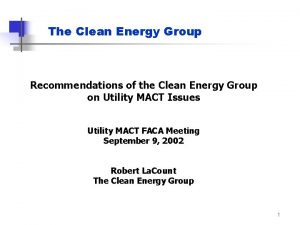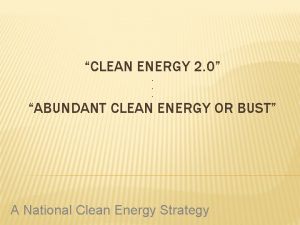The Clean Energy Group Recommendations of the Clean










- Slides: 10

The Clean Energy Group Recommendations of the Clean Energy Group on Utility MACT Issues Utility MACT FACA Meeting September 9, 2002 Robert La. Count The Clean Energy Group 1

The Clean Energy Group • Conectiv • Northeast Utilities • Consolidated Edison, Inc. • PG&E National Energy Group • Exelon Corporation • Public Service Enterprise Group, Inc. • Key. Span • Sempra Energy 2

HAPS To Be Regulated If EPA decides to regulate HAPs from electric utility steam generating units other than mercury from coal units and nickel from oil units, it should use appropriate surrogates for metals, acid gases and organic compounds. Surrogates should be used both to set MACT standards and for compliance purposes. CEG does not take a view at this time as to whether EPA has the authority to regulate other HAPs. 3

Subcategorization CEG believes that there are good reasons to minimize the number of subcategories to be established. A minimal number of subcategories reduces regulatory burden and ensures greater operator flexibility. CEG supports subcategories for (1) FBC units, (2) conventional pulverized coal (PC) boilers that burn lignite, and (3) conventional PC boilers that burn bitumininous and/or subbituminous coal. 4

MACT Floor CEG proposes the following approach for existing sources: • EPA should identify the top 12 percent of facilities from the available database. • It should then identify the primary emissions control technology used by the facilities in that group with emission levels at or better than the average for the group. • EPA should then look to all sources in the database using the identified control technology, provided the control was well designed and operated. • Finally, EPA should set the MACT floor such that the floor accounts for operational variability. CEG does not currently have a view as to how best to account for variability under worst-case operating conditions. For new sources, we propose a similar approach, except that the first step would involve identification of the control technology used by the best performing plant. 5

Beyond-the-Floor Regulation CEG believes that some of the new technologies for reducing mercury emissions from coal-fired boilers, including activated carbon injection, are promising and potentially cost-effective. 6

Format of Standard CEG supports: • allowing facilities to comply with either a rate-based or control efficiency standard; • output-based standards; • an annual averaging time. 7

Compliance Monitoring Method CEG supports the use of CEMs assuming that issues as to their reliability and accuracy are resolved to EPA’s satisfaction. Otherwise, compliance should be monitored annually using EPA Method 101 A for total mercury, in conjunction with annual RATA testing. Parametric monitoring of pollution control equipment could also be required on a reasonably frequent basis. 8

The Compliance Unit Compliance with MACT limits should be on a facility rather than an individual boiler basis. 9

Oil-Fired Units (Nickel) Any MACT standards for nickel should provide facilities with operational flexibility for compliance. The standard should be rate-based, and allow for the burning of natural gas for compliance. CEG recommends an annual averaging time. CEG shares the views of other stakeholders as to the adequacy of the database for nickel. 10
 Fe clean energy group
Fe clean energy group Fe clean energy group
Fe clean energy group Clean up everybody let's clean up
Clean up everybody let's clean up Energy energy transfer and general energy analysis
Energy energy transfer and general energy analysis Energy energy transfer and general energy analysis
Energy energy transfer and general energy analysis Clean energy smart manufacturing innovation institute
Clean energy smart manufacturing innovation institute Alternative energy sources definition
Alternative energy sources definition Clean energy regulator australia
Clean energy regulator australia Umass clean energy extension
Umass clean energy extension Retscreen manual
Retscreen manual Clean energy project analysis
Clean energy project analysis


















